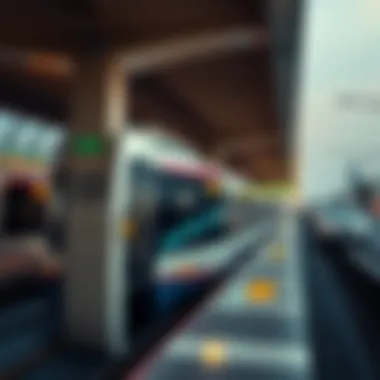Closest Metro Station to Palm Jumeirah: A Guide


Intro
Nestled along the azure waters of the Arabian Gulf, Palm Jumeirah stands as a testament to Dubai's flair for innovation and luxury. This man-made marvel, shaped like a palm tree, attracts sun-seekers, affluent residents, and savvy investors alike. But amid the allure of its opulence, a pivotal consideration looms: how accessible is this paradise? In this article, we delve into the closest metro station to Palm Jumeirah and explore its implications not just for commuters but for the broader dynamics impacting Dubai's real estate landscape.
Market Insights
Current Trends in Dubai Real Estate
The Dubai real estate market has been witnessing a resurgence in demand, particularly in prime locations like Palm Jumeirah. Various factors have fueled this upward trajectory. To start with, the pandemic sparked a renewed interest in properties offering spacious layouts and attractive amenities. Luxury apartments and villas have seen a notable surge in popularity among both international buyers and local investors.
Investors are keenly aware that proximity to effective public transport systems is a significant value enhancer. The ease of access provided by the Dubai Metro not only improves connectivity but also uplifts property valuations.
- Increased Interest in Rentals: Many properties in Palm Jumeirah cater to high-income expatriates looking for luxury rental options, further driving up rental prices.
- Shift Toward Sustainable Living: A growing awareness about sustainability has encouraged buyers to consider metro connectivity, as it reduces reliance on cars.
Economic Factors Impacting Property Values
Navigating the real estate waters requires being attuned to economic indicators. In the context of Dubai, a slew of economic factors plays a role in shaping property values. The continuous influx of tourists, robust job creation, and governmental initiatives to bolster the economy are all significant contributors. Furthermore, the Dubai Expo 2020 (delayed to 2021 due to the pandemic) is projected to streamline the city's growth, including its real estate sector.
Understanding economic trends is vital, especially for potential investors. A well-connected area, like Palm Jumeirah with easy metro access, tends to hold and appreciate property values over time.
"The synergy between public transport and real estate is undeniable; investing in well-located properties can yield substantial returns."
Investment Guides
Tips for First-Time Buyers
For those venturing into the Dubai property market for the first time, there are a few golden nuggets of wisdom to keep in mind:
- Research Thoroughly: Gain insights into local area trends, focusing on amenities, vehicle access, and public transportation options.
- Visit Properties Personally: Take the time to experience the neighborhood firsthand. This often uncovers nuances that online listings might miss.
- Engage a Local Real Estate Agent: A reliable agent familiar with Palm Jumeirah can provide invaluable guidance and negotiate better deals.
Portfolio Diversification Strategies
Real estate in Palm Jumeirah can serve as a fantastic asset within an investor's portfolio.
- Consider Different Property Types: From luxury villas to beachfront apartments, diversifying property types can mitigate risk.
- Leverage Short-Term Rentals: Properties near metro stations can attract tourists, offering lucrative short-term rental opportunities.
- Monitor Market Trends: Keep a close eye on nearby infrastructure developments; they can significantly impact property values.
A strategic investment approach, supported by comprehensive market analysis, can set investors on a promising path to success in Dubai's vibrant real estate scene.
For further information on Dubai's public transportation developments, feel free to check out these resources:
Understanding Palm Jumeirah
Understanding Palm Jumeirah is essential for anyone looking to grasp the subtleties of its allure and significance in the real estate landscape of Dubai. Shaped like a palm tree, this iconic man-made island is not only a marvel of engineering but also a beacon of luxury living, attracting investors, tourists, and residents alike. Its unique geographical position in the Arabian Gulf contributes greatly to its appeal, giving it a sense of exclusivity that is hard to miss. The palm's fronds are lined with lavish villas and upscale hotels, offering residents a lifestyle that combines tranquility with accessibility.
Geographical Overview
Palm Jumeirah's location is a key factor in its desirability. Nestled off the coast of Dubai, it lies in close proximity to the bustling urban center, making it convenient for those working in the city while providing a resort-like atmosphere. The island is connected to the mainland by a network of roads and the Palm Monorail, which enhances its accessibility.
Moreover, the island covers an area of about 5.4 square kilometers, hosting nearly 4,000 residential units and high-end hotels like Atlantis, The Palm. This makes it not just a residential area, but a hub for leisure activities. Whether it's fine dining, beach clubs, or scenic walks along the boardwalk, there is always something buzzing on the palm. The beauty of Palm Jumeirah lies in its seamless blend of luxury and nature, where stunning views of the skyline meet golden beaches.
Real Estate Landscape


The real estate landscape of Palm Jumeirah offers a unique blend of opportunities and challenges. Real estate here is characterized by extravagant properties, from luxurious villas to modern apartments. Each development is meticulously designed to offer either seaside views or direct access to lush community amenities.
Investors find Palm Jumeirah attractive due to its high rental yields and vibrant market. It attracts a mix of affluent expatriates and high-net-worth individuals looking for both a home and a sound investment. Buying property on the Palm not only symbolizes luxury living but also ensures that one’s investment holds its value over time. The demand for properties here remains consistently high, driven by Dubai's reputation as a global city.
However, the challenges are equally significant. Market fluctuations and the saturation of high-end properties can influence prices and limit buyers' options. Additionally, the ongoing global economic situation plays a role in investment decisions, making it crucial for potential buyers to stay informed and pragmatic.
Dubai Metro System
The Dubai Metro system plays a crucial role in shaping the urban landscape of the city, particularly for areas like Palm Jumeirah. Its efficient transport network not only connects different parts of Dubai but also significantly influences real estate dynamics. In a city renowned for its rapid development and extensive expatriate community, acknowledging the utility and benefits of the Metro system becomes indispensable.
Historical Context
The inception of the Dubai Metro dates back to 2006, a time when the city was rapidly expanding. The first line, known as the Red Line, opened in 2010 and was initially a project aimed at easing traffic congestion. Over the years, this initiative transformed into a high-tech transport solution. The Metro has since become a symbol of modern Dubai. Its development coincided with the UAE's vision to diversify its economy and enhance public transport, thus reflecting a broader commitment to sustainability and urban planning. The inception of this system can be seen as a response to the escalating population and the subsequent need to provide a reliable means of travel.
Current Lines and Accreditation
Currently, the Dubai Metro boasts two primary lines: the Red Line and the Green Line. These lines connect key areas, including major commercial hubs and residential areas, making commuting more practical.
- Red Line: Extending over 52 kilometers, this line covers numerous essential stops, including Nakheel, the closest station to Palm Jumeirah. It connects with other transport systems, allowing seamless transfers.
- Green Line: Not as extensive as the Red, this line spans about 23 kilometers. It complements the Red Line, adding accessibility to various neighborhoods across Dubai.
Both lines are automated and driverless, which showcases not only the technological advancements in Dubai but also its commitment to safety and efficiency. The Dubai Metro is accredited by international organizations, ensuring that it conforms to global standards of quality and service. Commuters can expect a high level of reliability and cleanliness, often noted through various traveler reviews and media reports.
In terms of operational metrics, the Metro carries millions of passengers annually, underscoring its popularity among locals and tourists alike. The strategic placement of stations within proximity to significant attractions, including Palm Jumeirah, enhances its relevance in the daily lives of residents and visitors. This accessibility serves to bolster the desirability of properties in the vicinity and aids in the overall attraction of the Palm Jumeirah area.
The Dubai Metro is not just a transportation network; it reflects the aspirations and innovative spirit of the city, intertwining the daily rhythm of life in Dubai with the pulse of development and growth. Understanding its backdrop is essential for those contemplating investment or residency in this evolving metropolis.
"The Dubai Metro has become a lifeline for commuters, providing an efficient and modern means of transport that mirrors the city's ambitious vision."
For anyone interested in further details about the Dubai Metro, you can visit the Dubai Roads and Transport Authority for comprehensive information.
Identifying the Nearest Metro Station
Understanding the nearest metro station to Palm Jumeirah is more than just locating a point on a map. It's about uncovering how public transport influences accessibility, lifestyle, and the ever-evolving real estate market in Dubai. Proximity to a metro station can significantly affect property values, and it also plays a crucial role in the attraction of new residents and tourists alike.
Station Overview: Nakheel
The Nakheel Metro Station stands as the closest link for anyone looking to access Palm Jumeirah via the Dubai Metro. This station isn't just a transit point but rather a gateway that connects commuters to various destinations across the city. Opened along the Red Line, Nakheel provides essential services catering to numerous users, whether they are locals or visitors.
Interestingly, the name 'Nakheel' resonates with Dubai's ambitious real estate developments, particularly the Palm Jumeirah itself, owned by Nakheel Properties. This connection reinforces the recognition and reputation of the station, making it vital for both daily commuters and tourists.
Distance from Palm Jumeirah
In terms of accessibility, the distance from Palm Jumeirah to Nakheel Metro Station is relatively short. The travel time can be wrapped up in about 10-15 minutes on foot, which is quite convenient when you consider the high foot traffic in the area. For the less inclined, taxis and ride-sharing options are also readily available, further shortening the commute.
The straightforward connection touches various main roads leading to the station, creating a seamless transition for those living in or visiting the Palm. Importantly, this proximity not only benefits daily commuters but also enhances the overall living experience in this luxurious area.
Alternative Stations: Dubai Marina and Al Sufouh
While Nakheel is the closest option, there are other metro stations nearby that are useful depending on your destination. Dubai Marina Metro Station, about 2 kilometers away, offers a different angle for those who might prefer the vibrant Marina district atmosphere instead. This station is well-connected, and it gives access to numerous retail outlets, dining options, and entertainment venues.
Similarly, Al Sufouh Metro Station could be considered as an alternative as it is also within a reasonable distance. Though it may not have the same direct benefits for Palm Jumeirah residents, it opens up transport options for getting to nearby areas like Jumeirah Beach and the larger Dubai area.
In summary, having multiple metro options within easy reach only serves to enrich the overall public transport experience around Palm Jumeirah, catering to a diverse range of commuting preferences.


Benefits of Proximity to Public Transport
The ease of access to public transport is a key factor influencing urban living. In a rapidly developing city like Dubai, proximity to the Dubai Metro is not just a matter of convenience; it can significantly shift the dynamics of residential and commercial real estate. This section dives into the specific benefits that such proximity offers, particularly in terms of property value and attracting a diverse population of tourists and residents alike.
Impact on Property Value
Being within close range to a metro station often translates to a premium on property prices. For investors, this is a crucial detail. According to multiple studies, properties near metro stations generally see a higher resale value. This trend isn't limited to just the Palm Jumeirah area; it's a pattern observed globally. Metro connectivity reduces commute times, which is a significant selling point for potential buyers. With quicker access to the city's business hubs, malls, and beaches, homes in these locations become more attractive.
For instance, consider properties in areas like Dubai Marina or Jumeirah Beach Residence, which are less than a stone's throw away from the metro. The compounding effect of accessibility turns these areas into gold mines for real estate investors. Investors can expect an impressive return on investment if they buy in regions that are just a short stroll from stations like Nakheel.
Moreover, properties with easy access to public transport tend to attract a more stable tenant base, which often leads to decreased vacancy rates. In the long run, this stability can enhance the overall value of the properties in the vicinity.
Attracting Tourists and Residents
Public transport does not merely serve the daily commuter; it also plays a pivotal role in tourism and local culture. With attractions like the Palm Jumeirah, proximity to a metro station means that tourists can journey to and from their hotels with ease. The ability to hop on a train and reach various hotspots reduces the stress and expense associated with using taxis or other forms of transport.
Moreover, the ease of movement encourages not only tourists but also potential long-term residents to explore the area. As the city grows, having transport options makes living in places like Palm Jumeirah much more appealing. Tourists can experience the vibrancy of Dubai without the hassle of navigating traffic jams or waiting for taxis. This accessibility creates latent demand for accommodations, whether short-term rentals in hotels or long-term leases in residential areas.
- Increased footfall often leads to growth opportunities for local businesses.
- Housing developments might see an uptick in interest from buyers and renters who prioritize convenient transport options.
In essence, the relationship between public transport and community growth is reciprocal. Enhanced accessibility fosters a thriving environment, attracting diverse groups of residents and creating an uplift in local economies.
"The accessibility of public transportation significantly enhances the desirability of residential locations, setting the stage for sustained property value appreciation."
By analyzing these benefits, it becomes abundantly clear that proximity to the metro station is not just a logistical advantage; it's a strategic move in the bustling real estate market of Dubai.
Future Developments in Public Transport
As Dubai continues to evolve, the public transport system plays a pivotal role in shaping the city’s vibrant landscape. With an increasing number of residents and tourists flocking to areas like Palm Jumeirah, the emphasis on efficient transport methods is paramount. Future developments in public transport not only affect the daily commute but also influence property values, investment opportunities, and overall quality of life in the area. Let’s delve deeper into what’s on the horizon for public transport in this dynamic metropolis.
Expansion of Metro Network
The future of Dubai’s metro system looks promising, with plans in place to broaden the network, aiming to cover more urban and suburban areas. Such expansions are critical for a number of reasons:
- Increased Accessibility: New metro lines will bring public transport closer to more residents, reducing reliance on private vehicles. This is essential in a growing city where traffic congestion can become a significant issue.
- Boosting Property Values: Properties near new metro stations generally experience a surge in demand. Investors paying attention to these developments can make strategic decisions that lead to significant returns.
- Environmental Benefits: Expanding the metro network aligns with Dubai's commitment to sustainability. An efficient public transport system can help reduce carbon emissions and traffic pollution.
One major upcoming project is the extension of the Red Line, which will eventually link to the Expo 2020 site and beyond. As such, locations like Palm Jumeirah stand to benefit from improved transport connectivity, making the area even more attractive to potential residents and business owners.
Innovations in Transport Services
In addition to expansion, innovations in transport services are paving the way for a smarter, more user-friendly commuting experience. These advancements include:
- Smart Fare Systems: The introduction of smart cards and mobile payment options can enhance user convenience, allowing seamless travel across various transport modes.
- Real-time Tracking: Commuters will soon benefit from apps that provide real-time information on bus and metro schedules. Such tools can significantly ease the travel experience.
- Sustainability Initiatives: New tram services and electric buses are the order of the day, promoting a greener mode of transport. Innovations like these demonstrate a blend of functionality and environmental responsibility that today’s travelers expect.
With these developments looming on the map, it paints a bright picture for public transport in Dubai. As we look toward the future, it is clear that the initiatives laid out will not just improve commuting experiences but also revamp the real estate landscape, ensuring it thrives in harmony with the city's growth.
"Investors should keep a keen eye on public transport updates; it's a clear indicator of growing areas that may soon see a rise in property values."
The impact of these expansions and innovations signifies much more than just convenience for daily commuters. For prospective buyers and investors in the Palm Jumeirah region, understanding these changes will be instrumental in navigating the evolving real estate market.
Comparative Analysis with Other Regions
When exploring the proximity of major metro stations to Palm Jumeirah, it becomes essential to draw comparisons with other surrounding areas. This not only provides insights into the accessibility offered by public transport but also helps gauge the overall benefits of living in such key locations.


Connectivity in Dubai Marina
Dubai Marina, a vibrant waterfront community, showcases a unique blend of leisure and urban living. Directly connected to the metro line, the area features the Damac Properties station, which serves as a pivotal node. This accessibility significantly enhances its attractiveness for both tourists and potential homebuyers.
- Commute Time: With the metro system, residents can reach Palm Jumeirah in a mere 10 minutes. This rapid transit framework gives Dubai Marina a notable edge in terms of convenience.
- Lifestyle Appeal: The Marina area boasts a plethora of restaurants, cafes, and recreational spaces. Its proximity to the metro fosters a lively ambiance, ensuring that both residents and visitors have a seamless experience commuting to beaches, shopping hubs, or entertainment venues.
This connectivity can be a decisive factor for individuals considering property investments. The ease of access to travel routes can amplify property values in the long run.
Transport Options in Jumeirah Beach Residence
In contrast, Jumeirah Beach Residence (JBR) offers another layer of urban living, albeit with a different transport scenario. While there is no direct metro stop within the JBR locality, its proximity to the nearest metro station at Dubai Marina makes commuting feasible.
- Alternative Transport: Residents often rely on local buses, taxis, or even water taxis that connect seamlessly to the metro. The local bus routes are strategically designed, providing a reliable link to the metro and minimizing inconvenience for residents.
- Urban Planning: The emphasis on planning in JBR underscores walkability. The area features beachfront promenades, making it popular among both tourists and those seeking a leisurely lifestyle. This focus on accessible urban design attracts an eclectic mix of people, ultimately fostering community engagement.
In comparing these areas, while Dubai Marina may have the upper hand in metro accessibility, JBR compensates with its unique lifestyle offerings and alternative transport options. Ultimately, understanding these dynamics allows investors to better evaluate their prospects in relation to public transport and property values in the broader Dubai market.
"Transport connections are often a silent hero in real estate value appreciation. Understanding them can give investors a clearer vision of where to place their bets."
This comparative analysis not only highlights the transportation options but also sets the stage for informed discussions about property investment potential in the diverse locales surrounding Palm Jumeirah.
Public Transport Etiquette in Dubai
Navigating the bustling landscape of Dubai’s public transport system involves more than simply hopping onto a train or bus. Understanding the nuances of public transport etiquette is essential for fostering a respectful and efficient commuter culture. Not only does it enhance the experience for individuals, but it also promotes a sense of community amongst the diverse population that calls this vibrant city home.
Guidelines for Commuters
Adhering to specific guidelines when using Dubai's public transport can make a considerable difference in both personal experience and social harmony. Here are some key points to keep in mind:
- Queue up: Form an orderly line at metro stations. There's an unwritten rule that chaos alleviates when everyone respects the queue.
- Priority Seats: These seats are designated for the elderly, pregnant women, and those with disabilities. It is a simple act of kindness to offer your seat if you are in a standard seat.
- Noise Levels: Keep conversations to a minimum. Not everyone is interested in your lively chatter about last night's soccer game. Keeping noise down encourages a peaceful atmosphere, perfect for those looking to rest after a long day.
- Food and Drink: Eating is generally frowned upon in transit. The metro stations and vehicles are often spotlessly clean—let’s keep it that way!
By embracing these simple guidelines, commuters contribute to a more pleasant public transit experience for all.
Cultural Considerations
Dubai is a melting pot of cultures, and this diversity brings with it a variety of customs and practices regarding public behavior. Recognizing and respecting these cultural norms is pivotal when utilizing the city's transport system.
- For instance, personal space varies across cultures. Some may be comfortable using the entirety of a seat, while others might prefer keeping a distance. Being mindful can go a long way in maintaining peace.
- Gestures can have different meanings in various cultures; avoiding overtly expressive actions may be a safer bet in public transport.
- Dress modestly and be considerate of others. Remember, Dubai has cultural sensitivities—what is acceptable in one environment may not be in another.
"Knowing the norms of public conduct not only enhances your travel experience but cultivates a spirit of mutual respect among all passengers."
In summary, public transport etiquette in Dubai is important as it enhances the overall efficiency of commuting while also showing respect to the diverse cultures representing the city. By adhering to guidelines and being mindful of cultural differences, individuals can contribute positively to the public transport culture, ensuring it remains a pleasant option for everyone.
Case Studies: Successful Real Estate Developments Near Metro Stations
The role of metro stations in shaping real estate landscapes can’t be overstated, especially in vibrant cities like Dubai. As we look into successful real estate developments near metro stations, we uncover how accessibility influences property values and community growth. Developers, potential investors, and even homebuyers would do well to pay attention to these dynamics.
Impact of Metro on Property Sales
When considering property sales, proximity to a metro station often becomes a key selling point. This is particularly true in Dubai, where the metro system is not just a mode of transport, but a lifeline connecting various neighborhoods. Properties within walking distance of Nakheel Metro Station, for example, have witnessed a notable appreciation in sales prices. Several factors make this happen:
- Convenience for Commuters: Metro stations streamline commute times for residents and workers. Those living near Nakheel can reach their offices in Dubai Marina or Downtown Dubai with ease, making these areas more desirable.
- Increased Foot Traffic: Businesses in proximity to metro stations typically benefit from higher foot traffic. This translates into better rental yields for commercial spaces. Residential properties close to such hubs often find themselves in demand, attracting buyers willing to invest more.
- Enhanced Lifestyle Appeal: Access to public transport adds a layer of appeal to properties. People look for easy options to travel around, whether for work or leisure, which directly influences their purchasing decisions.
"Accessibility is not just a matter of convenience; it is a crucial component of property value in metropolitan settings."
Investment Trends in Accessible Areas
Real estate investments tend to concentrate where accessibility is high. This trend becomes more visible when comparing property developments around metro stations like Nakheel and those located further away. Insight into current investment patterns reveals:
- Value Appreciation: Properties near metro stations tend to appreciate in value faster than others. Investors focused on long-term gains consider such areas prime targets due to the guaranteed demand.
- Diverse Buyer Pool: Easily accessible properties attract a broader spectrum of potential buyers, from young professionals to retirees seeking livable communities. This diversity creates a stable market, minimizing risks associated with fluctuations in demand.
- Government Initiatives: Often, developments around metro stations receive support from local authorities, boosting infrastructure improvements. This civic backing enhances property appeal, making such investments feel safer.
In sum, the synergy between metro accessibility and real estate success is evident through various case studies across Dubai. The connections created by the metro not only influence property values but also shape the community surroundings overall. For investors and developers, understanding these dynamics is pivotal in making informed decisions.







